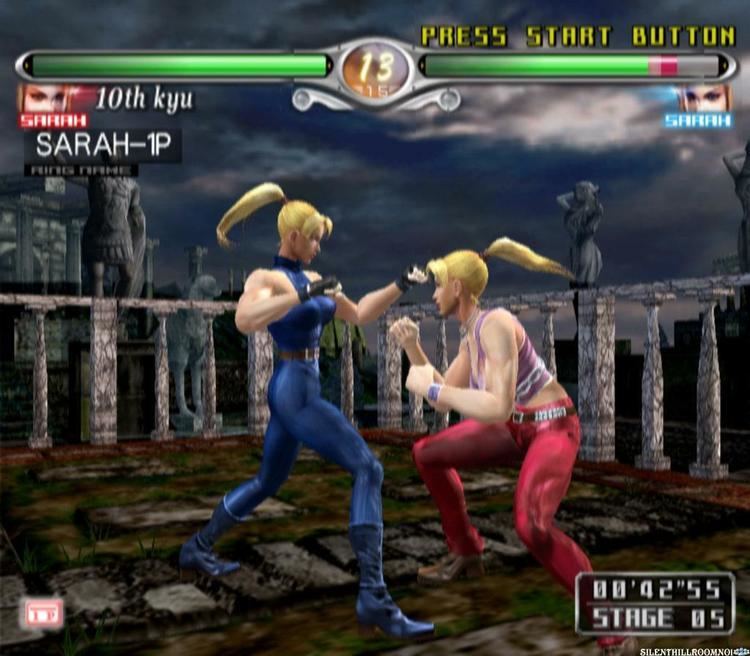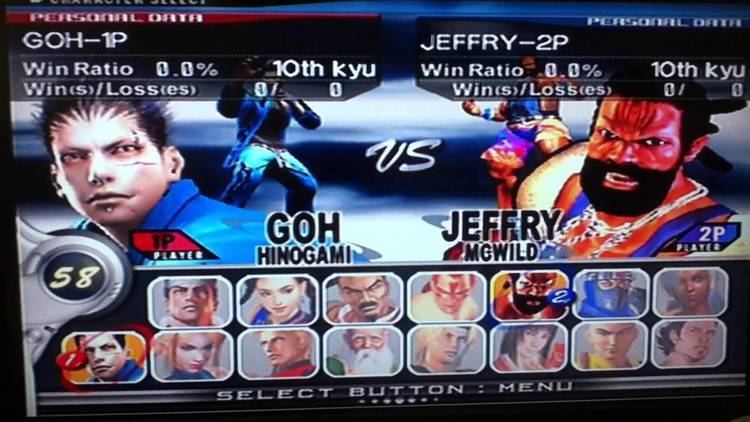9.4 /10 1 Votes
9.3/10 GameSpot Display Horizontally oriented | 9.3/10 IGN 94% Metacritic Publisher(s) Sega Cabinet Upright Initial release date 2001 Series Virtua Fighter | |||||||||||||||||||||||||||||||||
 | ||||||||||||||||||||||||||||||||||
Director(s) Yu SuzukiToru Ikebuchi Mode(s) Up to 2 players simultaneously Similar Virtua Fighter 4: Evolution, Virtua Fighter 5, Virtua Fighter 3, Virtua Fighter 2, Virtua Fighter | ||||||||||||||||||||||||||||||||||
Virtua Fighter 4 (Japanese: バーチャファイター4, Hepburn: Bācha Faitā Fō) is a fighting game by Sega. It is the fourth game in the Virtua Fighter series.
Contents
- Returning characters
- New characters
- Customization
- Training mode
- Changes from previous series releases
- Virtua Fighter 4 Evolution
- Virtua Fighter 10th Anniversary
- Virtua Fighter 4 Final Tuned
- Reception
- References

The game was first released in arcades on the NAOMI 2 board in 2001. A console port of Virtua Fighter 4, as well as that of Virtua Fighter 4: Evolution under the budget-priced "Greatest Hits" label, appeared on the Sony PlayStation 2 in 2002 and 2003, respectively.

In Japan, Virtua Fighter 4 is famous for spearheading and opening the market for internet functionality in arcades. VF.NET started in Japan in 2001, and since companies have created their own arcade networks, e-Amusement by Konami, NESiCAxLive by Taito and Square Enix, and ALL.Net by Sega and Bandai Namco.
Returning characters
New characters
Customization

A unique feature in Evolution was the ability to play in a tournament quest mode, where the concept was that the player was competing by traveling to various arcades, as opposed to role-playing as the player's chosen fighter. This mode was very popular due to the ability to buy cosmetic items to customize a character, as well as the ability to name a character. Many players of fighting games have unique styles; with the combination of various items allowing for vastly differing appearances a new depth of uniqueness was added. In addition, Sega took the top tournament players from the arcade version, and captured their style of play for the AI of a player's opponents for this mode. For example, playing against one Wolf character would be very different from playing another, because the actual player that character's AI was programmed to mimic had a unique play style.
Training mode

Virtua Fighter 4 introduced a comprehensive training mode. The mode consisted of an encyclopedia of fighting game terms, complete character command list walkthroughs, tips on all of the game's mechanics, recommended character combos, alternative options for failed combos, detailed command input timings, slow motion for frame counting and timing, and other useful training tips.
VF4's training mode consists of three sections:
Changes from previous series releases
Virtua Fighter 4 became much more streamlined and user friendly than its predecessors, while expanding on old ideas and adding new techniques. The evasion system was revamped from Virtua Fighter 3, the evade button was removed, and evades were split into two types, successful and unsuccessful. When evades were not performed with the proper timing, they were unsuccessful leaving the fighter vulnerable. The evade + throw escape option select, which was an advanced technique discovered in Virtua Fighter 3, was expanded upon. Virtua Fighter 4 allowed the player to escape as many throws as they could, and lengthened the window for performing a successful throw escape during an [unsuccessful] evade. A new move type called a Sabaki was added; an attack that also doubles as a reversal versus one or more move types.
The two new characters, Vanessa Lewis and Lei-Fei, had moves that employed these properties significantly more than the returning cast, and were quite experimental for Virtua Fighter characters. Vanessa Lewis is a black Vale Tudo/Muay Thai kickboxer with two completely separate moves sets that can be switched between on the fly, and Lei-Fei, a Shaolin monk, employs many stances that flow into one another.
Taka-Arashi, one of the new characters added to Virtua Fighter 3, was omitted, apparently due to the developers not being able to make him work properly with the Virtua Fighter 4 system mechanics.
The fighting arenas reverted to the old Virtua Fighter style of flat and square, as opposed to Virtua Fighter 3's wild and undulating stage designs. The reason behind this was to make the game less random, and more balanced and competitive in nature. Walls, however, were kept and expanded upon with a wall stagger/juggle system and several wall types including high + unbreakable, low + breakable, and low + unbreakable + open corners.
Virtua Fighter 4: Evolution
Evolution was an updated version of Virtua Fighter 4. The game introduced two new characters and adjusted every other character as well. The two new characters were the Judoka-assassin Goh Hinogami and the Muay Thai boxer Brad Burns. With the addition of Brad Burns, Vanessa Lewis's alternate Muay Thai style from Virtua Fighter 4 was removed and replaced with a Vale Tudo "Offensive" style; making her a solely Vale Tudo brawler.
All of the stages were adjusted. For example, Lei-Fei's stage in Virtua Fighter 4 previously took place during sunset, in Evolution it takes place during the morning.
Features:
In the US, Virtua Fighter 4: Evolution for PlayStation 2 also included as a bonus Virtua Fighter 10th Anniversary.
Virtua Fighter 10th Anniversary
With the 2003 PlayStation 2 release of Virtua Fighter 4: Evolution arriving in time for the series' 10th anniversary, a remake of Virtua Fighter, Virtua Fighter 10th Anniversary, was released exclusively on the PlayStation 2. While the music, stages and low-polygon visual style were retained from the first game, the character roster, animations, mechanics and movesets were taken from Evolution. In the previous PS2 release of Virtua Fighter 4, a button code would make the player's character look like a VF1 model. In Japan, the game was included as part of a box set with a book called Virtua Fighter 10th Anniversary: Memory of a Decade and a DVD. The box set was released in November 2003 and was published by Enterbrain. In North America, the game was included within the home version of Virtua Fighter 4: Evolution, and in Europe it was only available as a promotional item; it was not sold at retail.
Virtua Fighter 4: Final Tuned
Final Tuned is the final update to Virtua Fighter 4. This version of the game was released only into Japanese arcades, and it made some gameplay fixes and added new stages. Also, new customization items were added.
Reception
In July 2001, IGN's Anthony Chau praised the graphics of the arcade game, stating it is "one of the finest looking video games I've laid my eyes on" and "demonstrates the highest quality in visuals I've seen."
In Japan, the PlayStation 2 version sold 356,897 during its first week on sale in early 2002. The PlayStation 2 version went on to sell 541,973 units overall in Japan by the end of 2002. Worldwide sales of the PS2 port exceeded 1.5 million by June 2002.
On release, Famitsu magazine scored the PlayStation 2 version of the game a 37 out of 40. The game received universal critical acclaim (Metacritic 94/100), with perfect scores from GMR Magazine, PSX Nation, Hot Games, GamePro, G4 TV, Official PlayStation Magazine, Into Liquid Sky, and Cinescape. G4 TV called it "The best fighting experience available on home consoles." Writing for the Chicago Tribune, Levi Buchanan hailed Virtua Fighter 4 as "the greatest fighting game since Street Fighter II." Game Informer gave the PS2 release a 9.75/10, opining that "Underneath its silky shine is a feast of fighting goodies that will change everything you have ever come to expect from this genre." Game Informer later named Virtua Fighter 4: Evolution one of "The Top 50 Games of 2003," calling it "absolutely ingenious" and "the most balanced and challenging fighting game the world has ever seen."
Edge noted in retrospect that "Virtua Fighter 4: Evolution was unchallenged in having the best tutorial in fighting game history."
